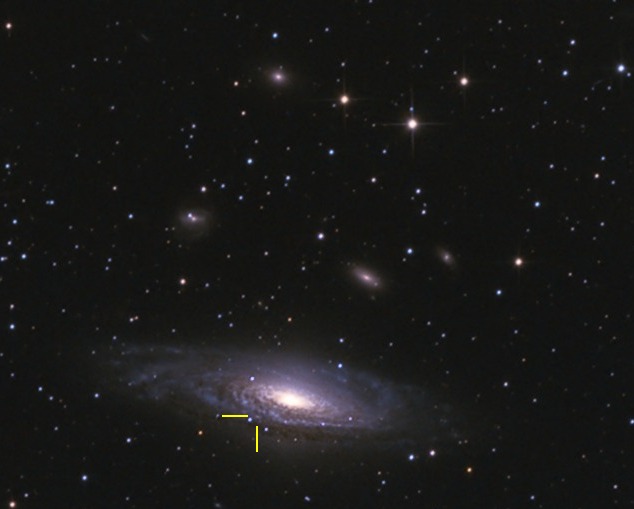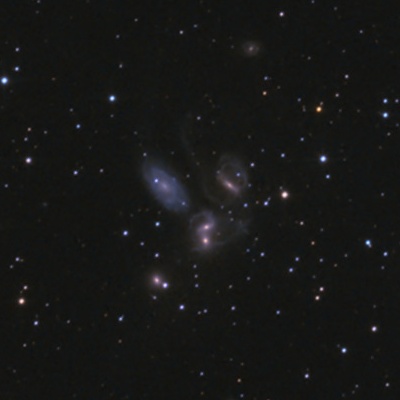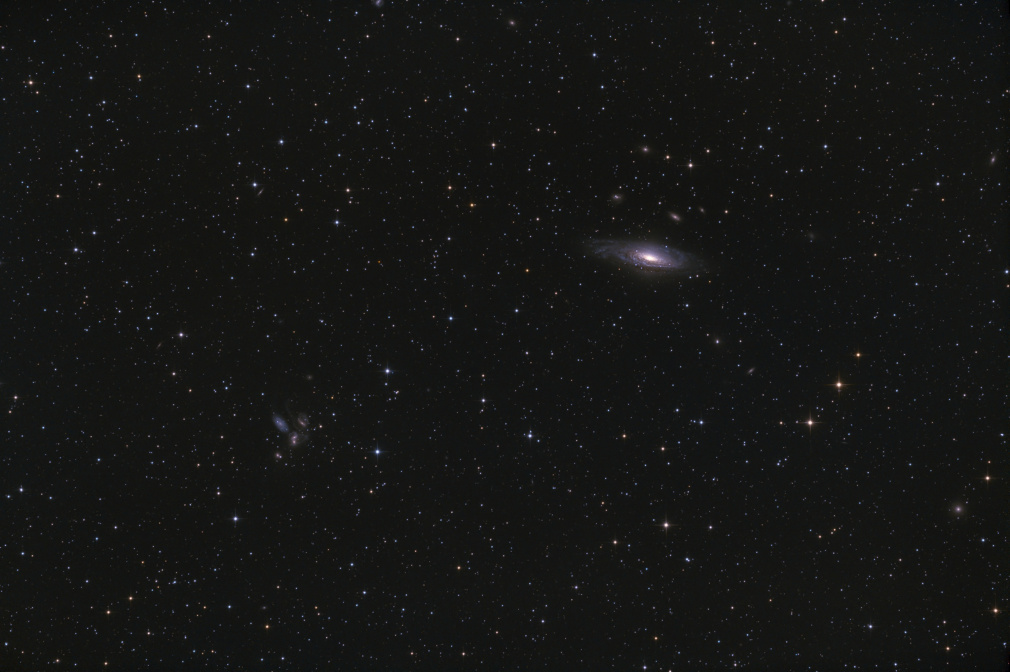NGC 7331, the largest galaxy in the picture looks quite similar to the galaxy we live in, the Milky Way. Due to the similarity it also used to be called as the Milky Way's twin. With other four galaxies, NGC 7331 forms the Deer Lick Group of Galaxies. The name of the group comes from an amateur astronomer Tomm Lorenzin, who was astonished while he was observing the group from the Deer Lick Gap in North Carolina. The other group in the lower left corner of the picture is the Stephan's Quintet, named after its discoverer.
NGC 7331 and The Deer Lick Group
 NGC 7331, the brightest galaxy in the group was discovered by William Herschel in 1784, being one of the brightest objects missed by Messier. Its distance is about 40 million light-years. NGC 7331 is believed to be very similar to our galaxy, the Milky Way, concerning its mass, structure and star distribution.
NGC 7331, the brightest galaxy in the group was discovered by William Herschel in 1784, being one of the brightest objects missed by Messier. Its distance is about 40 million light-years. NGC 7331 is believed to be very similar to our galaxy, the Milky Way, concerning its mass, structure and star distribution.
Unlike in other spiral galaxies, the central bulge of NGC 7331 rotates in the opposite direction to the outer parts of the galaxy. This phenomenon is not understood yet totally, the most probable explanation is that the bulge was formed recently by infalling dust and gases.
The other galaxies in the group are NGC 7335, NGC 7336, NGC 7337 and NGC 7340. These galaxies look smaller in the picture because they are much farther, between 280-400 million light-years from us. As their distance is about 10 times the distance of NGC 7331, and their apparent size is about 1/10th of NGC 7331, their actual size must be comparable to the size of NGC 7331.
There have been only two supernovae identified in NGC 7331 so far. One in 1959, identified as SN1959D a Type II supernova discovered by Milton Humason, the other in April 2013 identified as SN2013bu also a Type II discovered by Koichi Itagaki. Brightness of SN2013bu was about 16 magnitude at the time of discovery then it brightened to 14-15 magnitudes by May and then it started to dim. At the time of creating this photography its brightness was only 19 magnitudes, fortunately still visible in the picture. Yellow marks show the position of the supernova in the picture to the right.
Stephan's Quintet
 Stephan's quintet can be seen in the lower left corner of the image, as its name suggests it consists of five galaxies. The group was named after its discoverer, Éduoard Stephan French astronomer who worked in Marseilles Observatory at the time of the discovery in 1877.
Stephan's quintet can be seen in the lower left corner of the image, as its name suggests it consists of five galaxies. The group was named after its discoverer, Éduoard Stephan French astronomer who worked in Marseilles Observatory at the time of the discovery in 1877.
Stephan's Quintet is one of the most studied galaxy group, because of the intense gravitational interaction between four of its members (except NGC 7320).
The brightest galaxy in the group is NGC 7320 appearing bluer than the others, the explanation is simple: it is much closer than the others, thus its radial velocity and redshift is smaller. Actually its distance is about 36 million light-years while the others are in 270-300 million light-years from us. The farther galaxies (NGC 7317, NGC 7318a, NGC 7318b and NGC 7319) are interacting with each other, while NGC 7320 is physically independent from them, it is just accidentally visible in the same direction as the others.
NGC 7317 (at the bottom) is an elliptical, Seyfert 2 type galaxy having a super massive black hole with a mass of 10-100 million solar masses at its core. The two spiral galaxies at the center are NGC 7318a and NGC 7318b colliding with each other. The spiral galaxy to the right of the bluish NGC 7320 is NGC 7319, another Seyfert 2 galaxy. Its arms are being distorted by gravitational forces within the group.
The tiny faint barred spiral galaxy above the others is NGC 7320C. Probably it is the fifth physically connected galaxy, as its distance is similar to the others, and a tidal tail seems to point towards it from NGC 7319.
